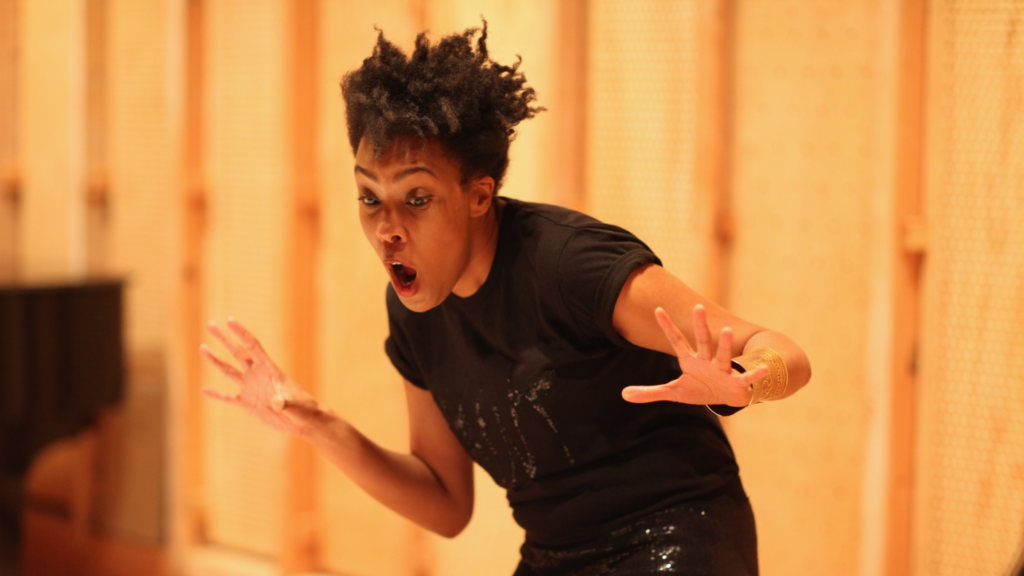Light in the Darkness
Interview
Tansy Davies goes deeper than most composers dare to do and emerges with music of clarity and hope. Amanda Holloway looks at her fruitful long-term partnership with the London Sinfonietta.
Tansy Davies is a force of nature: her music, like her physical presence, is a compound of earth and air. It summons up the grinding of rocks and the crackle of electricity – she writes for ‘trash metal’, prepared piano and thunder sheets, against growling bass clarinet and bassoon. When Davies talks about composing, her words are detailed, specific and very down-to-earth. But the adjectives she uses to describe her impulses refer to the spirit world and she herself resembles a sort of Ariel – slim, strong with spiky sculpted hair pointing to the heavens.
Davies is interested in the links between humans and nature, ‘the belief that there are other logics around us that are not just human intelligence, and which we can try to learn from.’ This belief crystallised into an ambitious, site-specific music theatre piece, Cave, commissioned and performed by London Sinfonietta in 2018. It was the pinnacle of a relationship with this risk-taking ensemble that started in 2001. Chief executive and artistic director Andrew Burke says ‘Back then we played some of her early works, including Small Black Stone and that led us to commission a work in 2004 through our Blue Touch Paper scheme which became the saxophone concerto, Iris.’
When planning the Sinfonietta’s contribution to Venus Unwrapped in 2019, Burke thought immediately of Davies’s music. ’I thought about the female composers in the last 20 years with whom we’ve made a relationship and Tansy was the natural fit for us.’
‘It’s all about paring it down, taking away the complexity of modern life’
The title of the programme is Jolts and Pulses – a spot-on description of one of Tansy’s most popular and percussive early works, Neon, which the Sinfonietta has toured around the world. Written in 2004, the instrumentation includes junkyard percussion, amplified bass clarinet and strings. Davies admits she was very surprised at its success. ‘I wrote it quickly for a one-off concert, using some leftover material in a collage. It was playful, and I expect some of my contemporaries, who like me came from a serious modernist aesthetic, might have thought it was “light music”. But I was very happy with the way it came out and the life it’s had.’
Davies’s music is often described as urban, perhaps for its grungy beats and use of industrial materials alongside the classical instrumentation. ‘But I don’t see that as being different from nature,’ she says. ‘It’s all about paring it down, taking away the complexity of modern life. Nature is the great teacher. It helps me to try to understand who I am, and become part of where I come from.’ Her music is not about pretty landscapes, however.
‘‘How incredible to have these musicians come into your dream and make it come true’’
Davies goes to some very dark places, particularly in her two operas, Between Worlds and Cave. ‘Both were very soul-searching subjects. They were about going into the darkness, and finding something that you can shine a light on and bringing something positive to the surface.’
Between Worlds was set in one of the Twin Towers of the World Trade Centre on 9/11. Cave was an original story about a man searching for his daughter in a post-apocalyptic scenario, charting his grief and redemption in the context of climate change. Producing this ambitious music theatre piece was a big undertaking for the Sinfonietta, and Andrew Burke is still buzzing with the excitement, ‘I enjoy all her music – but I have wonderful memories of Cave. The sound world is beautiful and moving and the storytelling is very clear. In Cave she has evolved her style, yet it’s still music by Tansy. To create such a recognisable music language is a relatively rare thing.’
Extreme vocalist Elaine Mitchener was ideal for the shamanistic, animal presence that Davies created as Mark Padmore’s spirit guide in Cave. ‘I remember Elaine coming towards me and feeling this incredible furnace of energy, this wild earthy woman, and I thought, “Oh my god, this woman is as scary as me, I have to work with her!” Now Davies is exploiting Mitchener’s unique voice in a new commission for the Sinfonietta’s Venus concert, which also includes composers who have influenced or interested Davies, as well as favourites from her back catalogue.

© Jana Chiellino
It’s not a retrospective, but a tribute to Davies’s achievements, says Burke. ‘She’s passed a point in her career now where it’s absolutely no longer a question about whether she’s going to be an important voice – she already is. We are naturally dealing with a different calibre of composer and artist now, in 2019, than when we first started playing her music. Still being in a relationship with her and her music is something this ensemble is very proud of.’
When asked for her advice to a new composer Davies is tough but encouraging. ‘It is seriously hard work, non-stop, unless you’re very lucky. But you must dream big, and believe in what you’re doing.’ Over the last two decades, her music has been performed by everyone from the Sinfonietta to the New York Philharmonic. ‘How incredible to have these musicians come into your dream and make it come true,’ she says modestly. ‘It never ceases to amaze me when that happens to me.’